Mazda
|
1930 - Present |
Country: |
 |
|
We admit it - we love Mazda's. They are reliable, well built and affordable. Better still, they are drivers cars. If you are a regular visitor or member of the
Unique Cars and Parts web site, you would well know our preference (and most others for that matter) for rear wheel drive - so the model of Mazda that has secured a berth in the
Unique Cars and Parts garage is pretty obvious.
But the story of Mazda does not start in our garage. In fact, the Mazda name has its origins in an ancient Persian religion based on the recognition of the dual principle of good and evil or light and darkness - Mazda being the good principle. All Mazda's have their origins in an undertaking established in 1920 called the Toyo Cork Kogyo Co Ltd.
In 1921, the president of the company, Jujiro Matsudo, father of the 1977 president, directed the company's efforts into machinery production until, in 1923, the devastating Kanto earthquake levelled Tokyo, destroying all means of transport - which were at the time cattle, carts and wagons.
Impressed by the efficiency of the Model T Ford trucks which were drafted in to help in the relief work, Matsudo seized the opportunity of adapting the technology his company had been using to produce machinery into the manufacture of motor cycles.
Exhaustive studies of British and German motor cycles resulted in the Toyo Kogyo technicians developing their own engine, a two-stroke 250cc unit, which was installed in an effective, although short-lived, machine. Then, in 1930, the first Mazda three-wheeler was designed and developed. Again based on foreign products, it went into full production in October 1931 as the DA-type 500cc model.
While other Japanese companies were relying on bought-in parts, Toyo-Kogyo were manufacturing and producing their three-wheelers as integral products in a new, purpose-built factory, adjacent to Niho Village, the birthplace of the company's president. In January 1934, the company produced a 485cc DC-type three-wheeler at a rate of 114 units per month, breaking the previous production rate record of 100 units a month.
In October of the same year, they produced a 654cc KA-type engine, and the 485cc unit was phased out. In July 1935, the KA-type was improved and designated the TCS; five months later, the KC-type was introduced with further modifications. By June 1937, Toyo Kogyo were producing vehicles at a rate of over 300 units a month, topping their range with a 669cc GA-type three-wheeler in April 1938.
The Sino-Japanese Incident
A year earlier, however, the company had moved as far as importing machinery, including a body press, for the production of a car, but the Sino-Japanese Incident, which eventually became merged with the war in the Pacific, meant that these plans had to be abandoned. Production of three-wheelers was run down as the production of rifles for the armed forces was stepped up. Even so, the company produced a number of
prototype passenger cars, culminating in a perfected model in 1940, but this too was abandoned as the war effort gradually increased in tempo.
By 1940, the deterioration of the military situation was such that all efforts outside of the war had to cease, the Toyo Kogyo facilities being exclusively geared to producing armaments. The dropping of the first atomic bomb on Hiroshima on 6 August 1945, killed over 400 of the company's employees, destroyed 40 per cent of their production machinery and paralysed production. The reconstruction of the Toyo Kogyo Co after the war was greatly hampered by the lack of skilled labour and the shortage of raw materials. Nevertheless, production of three-wheelers rose from 10 vehicles in December 1945 to over 200 vehicles a month in 1947.
1948 saw the expansion and modernisation of the production facilities with the result that the company was producing 500 vehicles a month by the end of the year, increasing to 800 a month by December 1949. In March the following year, a longer-bodied version of the GB, the LB, was introduced and the out-break of the Korean War in June
1950 brought an increased demand for Toyo Kogyo's products. Three-wheelers became larger and larger and new models were released one after another.
The First One-Ton Three-Wheeler Produced in Japan
When the artificial boom created by the war declined, the Japanese economy was on the way back to recovery and, in September 1950, Toyo Kogyo launched the CT, the first one-ton three-wheeler produced in Japan. New model followed new model until in October 1954, when Toyo Kogyo introduced the CHT A powered by an
air-cooled, two-cylinder, overhead valve, 38.4 bhp unit with a displacement of 1400cc. It was also in 1954 that Toyo Kogyo produced 32,094 vehicles, more than four times the number produced in 1949.
While Toyo Kogyo continued to improve and develop their production facilities, including the adoption of a new steel-moulding process, work also went into developing their three-wheel vehicles and, in addition to styling changes, an automatically cooled engine was developed, dual ventilator systems added for passenger comfort and improvements were made to the oil circulation system. Research also led to a complete redesign of the
steering system which enabled the company to produce three-wheeled models in the 1.5 to 2-ton class.
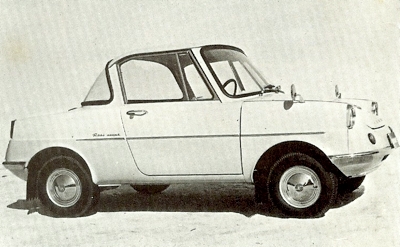
The 1960 Mazda R360, which was powered by a twin-cylinder 356cc engine.
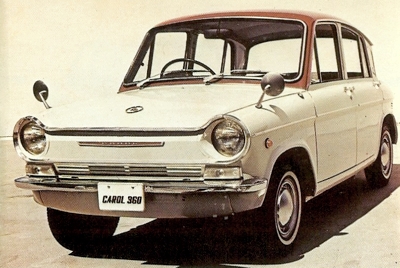
The 1962 Mazda Carol 360 Wagon, it was a slightly stretched version of the R360, with two extra doors and seats, but still powered by the 356cc twin-cylinder.
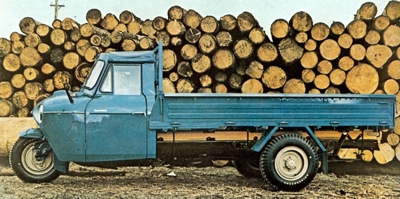
1964 Mazda 3-Wheeled truck - the perfect workhorse for Japan.
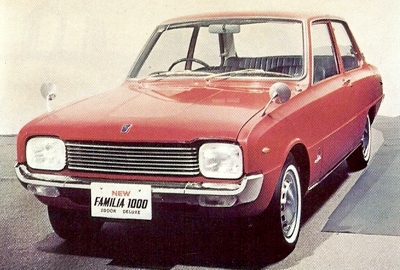
The 1968 Mazda Familia 1000 sedan was fitted with a 987cc 4 cylinder engine.
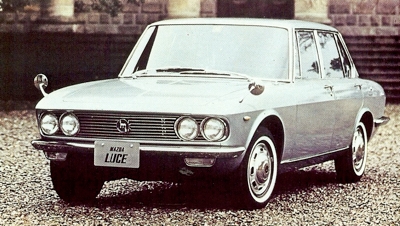
The 1500cc Mazda Luce of 1964.

The rotary-engined Mazda RX2.
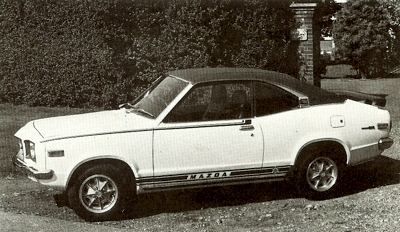
A rare publicity shot of a Mazda RX3 in 'Celebration' guise, sporting alloy wheels, boot spoiler and decals.
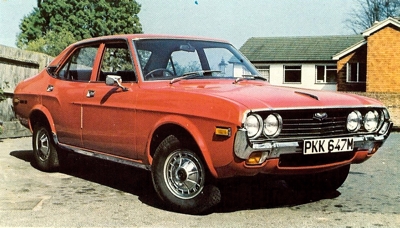 The Mazda 929 sedan was a derivative of the ill-fated RX4 Wankel engined model, which was still being made in Japan at the same time as the 929, but had been rejected by world markets. The Mazda 929 sedan was a derivative of the ill-fated RX4 Wankel engined model, which was still being made in Japan at the same time as the 929, but had been rejected by world markets.

The car most remember, the trusty Mazda 343. It's competition included the likes of Leyland's Marina, so it is pretty obvious why it was so successful.
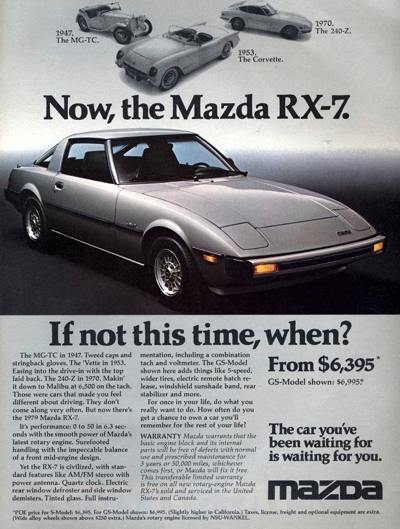
The Mazda RX-7 - a car that needs little introduction.

A publicity shot of a Mazda MX-5 NC Update. If you don't believe 2 litres would be capable of testing your driving abaility along the twisty stuff, you have not driven one. It has definately earned its spot in the Unique Cars and Parts garage.
|
The Romper
Clutch and driver comfort improvements followed and the company employed their first column-shift
gear lever. The final improvement was the gradual changeover from air to water cooling. Anticipating a move towards small, four-wheeled vehicles, Toyo Kogyo introduced a two-ton, four- wheeled pick-up in April 1958. Known as the Romper, it was powered by a 35 bhp, V-twin overhead-valve engine. In July of the same year came the Romper 11, a 1.75-ton model with' a 42 bhp, 1400cc engine.
The following year two further models, the D1100 and D1500 were launched. The one-ton D1100 had a 1139cc unit delivering 46 bhp, and the D1500 a 1484cc unit giving 60 bhp. Both engines had overhead camshafts, and were used in Toyo Kogyo's last three-wheel model launched in October 1959.
The company had begun development work on an ohc engine in
1950 after they had developed the CT-type
air-cooled engine. At the same time, the company began to use shell-mould techniques for making engine parts such as
cylinder heads, cylinder blocks and crankshafts. A major step forward, the company could now manufacture main parts for their water-cooled engine from ductile cast iron instead of the previously used ordinary casting.
First on Four Wheels - The Mazda R360 Coupe
Spurred on by the success of the small car in Europe, Toyo Kogyo produced their first four-wheeled car on 23 May 1960 - the Mazda R360 coupe - a car which was designed to bring motoring in Japan within the reach of everyone. The R360 was produced in two versions: the KRBB which had a conventional transmission and sold for 300,000 Yen, and the KRBC with a torque converter, which sold for 320,000 Yen.
Powered by a rear-mounted,
air-cooled, two-cylinder 356cc engine, the R360 had an overall length of 2980 mm and width and height both of 1290 mm. Curb weight was a mere 837lb. as a result of the use of light-alloy materials in the
unitary construction and aluminium for the power unit and other components. Suspension was independent all round with double acting shock absorbers and torsion bars. Maximum speed was 90 kph.
In February
1961, a small B360 four-wheeled truck was released which had a load carrying capacity of 350 kg and was capable of a maximum speed of 67 kph. The following May, a B360 van made its debut. A B1500 four-wheeled truck was added to the range in August of the same year. At the Japan Motor Show in
1961, Toyo Kogyo launched their second new car, the two-seater Mazda 700, but plans for its production were shelved in favour of the two-door, four-seater Carol 360.
The Mazda Carol 360
Powered by a 358cc 18 bhp, four-cylinder, in-line, water-cooled, aluminium-alloy engine, the Carol was styled along the lines of the Ford Anglia, in particular adopting the Ford's 'cliff cut' rear window. A four-door 20 hp version was introduced in September 1963. By March 1962, the year in which the company signed a design licence agreement with the Italian stylists
Bertone, Toyo Kogyo had added a de-luxe model to its B360 fleet, following that with the release of a new B360 van in May 1963. This newly designed B360 was equipped with a water-cooled engine, replacing the
air-cooled unit of the previous model. At that time it was the only small four-wheeled vehicle to be equipped with a water-cooled engine.
One Million Mazda's
In April
1963 Mazda modified the D11OO and D1500 models to take larger power units, inserting a 1484cc engine into the D11OO and a new 1985cc unit into the D1500, making the former the D1500 and the latter the D2000. In March 1963, Toyo Kogyo's one millionth vehicle had rolled off the production line. It had taken 29 years and four months to produce the first half million and only two years and two months to produce the second half million.
The Mazda Familia / Mazda 800
Late
1963 saw the introduction of the Familia pick-up which, powered by a new four-cylinder 782cc, 42 bhp engine, had a maximum speed of 105 kph, could accommodate two passengers and had a loading capacity of 400 kg. The adoption of the Familia pick-up into a saloon - a reversal of the traditional Japanese practice of developing a saloon before a truck - came in October
1964 in the form of the four-door Familia saloon. Exported as the Mazda 800 sedan, it was powered by the same 782cc 48 bhp four-cylinder engine as the pick-up, but had a top speed of 115 kph. A month later, a two-door standard version was added together with a two-door special, and a month later still a 500 kg capacity pick-up was added to the commercial range.
The Mazda 1500
From 1964 to the end of 1965 Japan's economy again went into a slide and economic growth was minimal. 1966, however, saw an upward turn and the introduction of the Mazda 1500. Although the car had first been introduced at the
1963 Tokyo Motor Show, constant development work kept it off the market until then and much of Bertone's styling work had, in the meantime, been altered.
1966 was the year which saw Toyo Kogyo produce their two millionth vehicle and complete a new assembly plant at Ujina.
Toyo Kogyo's First Rotary
A year earlier, Toyo Kogyo had signed an agreement with Perkins Engines in the UK and the result was the development by Toyo Kogyo of a 2500cc diesel engine which was first used in the E2500 truck in January
1967. A 3800cc unit was introduced two years later. The most significant event in
1967, however, was the introduction of Toyo Kogyo's first rotary-engined car, the Mazda 110S.
Toyo Kogyo's then president Matsuda and six other representatives of the company went to West Germany in October
1960 to negotiate for a licence to develop the Wankel engine. In November
1961, the first NSU rotary engines arrived at Toyo Kogyo's research and development facility and work began on developing an engine which could be used in a mass-produced vehicle.
The Twin-Rotor Engine
The company's first
prototype engine, however, showed excessive vibrations at idling speed, emitted large amounts of white smoke and suffered from excessive oil consumption. After 200 hours of running, the output dropped and it was found that the electroplating had fallen off. Undeterred, in
1962 a
prototype engine was fitted into a small test car but this too suffered from idling vibrations and the decision was taken to begin experiments with a twin-rotor engine, on which there was much less technical data available.
Kenichi Yamamoto
In April
1963, a Rotary Engine Development Division was set up under manager Kenichi Yamamoto and gradually problem after problem was overcome. Chatter marks on the inside of the housing were cured by the development of a new apex seal; a side-port induction system was developed and a new gear mechanism was adopted. Although research was concentrated on the twin-rotor engine, work was also carried out on three and four-rotor units.
The Mazda 110S Cosmo
Work was switched in
1964, however, to the development of a 500cc twin-rotor engine, and thanks to the valuable lessons learned in the past years of research and development, this was completed with few problems and became the
prototype of the engine which went into production in
1967. Work on the design of a
prototype car to carry the rotary engine had begun in
1962 and, in August
1963, after exhaustive trials a
prototype car was completed - the
Mazda 110S Cosmo.
Development work continued and, in October
1963, Toyo Kogyo displayed two types of rotary engine, a 400cc single-rotor and an 800cc twin-rotor, at the Tokyo Motor Show. A year later, the company showed a twin-rotor engine with a single chamber capacity of 400cc and a four-rotor engine. Field tests on the 110S were carried out parallel with bench tests and, with the completion of the company's new Muyoshi proving ground in 1965, final pre-production tests were carried out at a much quicker rate enabling the car to be distributed to dealers throughout Japan for further tests.
The First Twin-Rotor Engined Car in the World
No major problems were found, but a four-barrel carburettor was added to improve performance. The car finally went on sale in May 1967 as the first twin-rotor engined car in the world. In July 1968, the company introduced the Mazda R100 coupe powered by a twin-rotor engine with a single rotor capacity of 491cc and, in July 1969, the Mazda R100 sedan.
In October, the Mazda R130 coupe made its debut powered by a twin-rotor engine with a single chamber capacity of 655cc. Competition participation played a role in the public acceptance of the rotary engined cars and, consequently, although a Toyo Kogyo factory team entered a class-winning Mazda 800 in the Singapore
Grand Prix in 1966, it was with the Mazda 110S that the factory entered the 1968 Marathon de la Route 84 Hour Endurance Race and took 4th place.
The Mazda RX2 and RX3
A Mazda R100 coupe won an overall victory in the Saloon and Touring-Car Class at the 1969 Singapore
Grand Prix and took 5th and 6th places in the
Spa 24 Hour Race in the same year. The 1969 Marathon de la Route 84 Hour Endurance Race ended with another Mazda R100 taking 5th place. A year later, another Mazda R100 took 5th place overall in the
Spa 24 Hour Race. Setting the seal on the competition successes of the factory, 1972 saw the Mazda
RX3 and
RX2 taking the first, second and third places in the Japanese GP.
Despite the successful development of a rotary-engined car, new orthodox-engined cars continued to be introduced. November 1967 saw the launch of the Mazda 1000 sedan and December 1968 the Mazda 1800. 1970, Toyo Kogyo's 50th anniversary, saw drivers M. and H. Castaing driving a
Mazda 1200 saloon to victory in the 39th Monte Carlo Rally and the launch of the Mazda 1300 series. In saloon, coupe and wagon versions, the 1300s were powered by a new 1272cc ohc engine.
It was also the year of the exhibition by Toyo Kogyo of ten
prototype electric vehicles at Expo 70 held in Osaka. In May of the same year, Toyo Kogyo launched their
RX2, powered by a twin-rotor engine with each chamber having a 573cc capacity. At the same time, the company launched the 616, a 1600cc reciprocating engine model with the same body styling as the
RX2. A major step forward for the company, however, was the export to America in April 1970 of the first shipment of Mazda's.
Breaking Into The American Market
Sales in the USA were begun by Mazda Motors of America (NW) Inc, which opened its doors on 27 May, to handle sales in Washington and Oregon. Six weeks later, the export of rotary-engined cars to the States began when 60
Mazda R100s were shipped on 6 June. At the same time, the USA sales network was being expanded. Mazda Motors of Florida Inc, went into operation in Jacksonville in June; Mazda Motors of Texas Inc was established in Houston and, by February
1971, the network was almost complete when Mazda Motors of America Inc was set up in Compton, California.
The following year, Mazda Motors of America Inc began selling Mazda’s in the East and Middle West of the USA and the Mazda RX2 (Capella) received the 1972 Import Car of the Year Award from 'Road Test' magazine. Less than three months later, the same award went to the
RX3 (Savanna) station wagon. Also in 1973, all the Mazda distributors in the USA were merged into Mazda Motors of America Inc, and that year sales of Mazda’s in the US topped the 119,000 mark.
By September
1974, Mazda had 390 US dealers and were retailing RX2, RX3, RX4, 808 and the B1600 rotary-powered pick-up models. Total Mazda vehicle production topped the four million mark on 30 March 1971, with the three-million mark being passed only fourteen months before. On 6 September
1971, Toyo Kogyo introduced two new models, the
Rotary RX3 (Savanna) and the 808 (818).
The Mazda Chantez was launched in June
1972, powered by a 360cc water-cooled two-cylinder engine. In the October of the same year, the Mazda RX4 was launched. The Mazda 929, utilising the same body as the RX4, went on the market in April
1973. In
1975, the
RX4 was to form the basis for the 929 range using 1800cc reciprocating engines instead of the rotary units which were losing popularity. The older
RX3 became the four-cylinder 616.
The Iconic Mazda 323
A new 323 Hatchback model was introduced in
1977, a car of vital importance to Mazda's future as it was designed to compete in what was fast becoming the world's most competitive market sector. But financial problems from the 1960's remained, and the company sought a new financial investor - in this case the Ford Motor Company. Starting in
1979 with a 7-percent financial stake, Ford began a partnership with Mazda resulting in various joint projects.
Project X605
To remain viable as a company Mazda was forced to concentrate on manufacturing traditional
piston driven engines, however the engineers never gave up on their dream of creating another sports car using rotary power, and in
1978 (following 2 years of extensive development code named Project X605), they introduced to the world the fabulous RX-7. While the car was released in the US in 1978, it took another year for it to reach Australian shores, and what an impact it had, many traditional Holden and Ford V8 buyers deserting their traditional brands to savour the exciting new RX-7.
Development of the car had been led by project head Moriyuki Watanabe, (who would eventually become chairman of the board), and unlike the complex and expensive to manufacture Mazda Cosmo, engineers created a simple and more affordable sports car. Certainly the concept of an affordable sports car was welcomed by the motoring public, however Mazda's cost cutting measures did leave the car with some minor shortcomings. First up, the Mazda used re-circulating-ball
steering instead of a more-expensive rack-and-pinion setup, and Mazda settled for rear drum
brakes rather than discs.
But perhaps the biggest disappointment for the enthusiast was that Mazda decided to use a live-axle located by four trailing links and a Watt linkage rather than a fully independent setup. The original 12A two-rotor engine displaced a mere1146 cubic centimeters, developed a mere 100bhp at 6,000 rpm and 105 pound-feet of torque at 4,000 rpm - although production modifications saw power increase to 135bhp. In all, some 500,000 original RX-7's were built, making it, by a huge margin, the best-selling rotary-engine car of all time.
Cars for those who like to wear Cardigans
During the 1980s, Ford gained another 20-percent financial stake. These included large and small efforts in all areas of the automotive landscape. This was most notable in the realm of pickup trucks (like the Mazda B-Series, which spawned a
Ford Courier variant in North America) and smaller cars. For instance, Mazda's Familia platform was used for Ford models like the Laser and
Escort, while the
Capella architecture found its way into Ford's
Telstar sedan and Probe sports models.
The Probe was built in a new Mazda assembly plant in Flat Rock, Michigan along with the mainstream
626 sedan (the North American version of the Capella) and a companion Mazda MX-6 sports coupe. The
Mazda 121 sold in Europe and South Africa was, for a time, a variant of the Ford Fiesta built in plants in Europe and South Africa. Mazda also made an effort to sell some of Ford's cars in Japan, mainly through their Autorama dealer group.
This was an era when few would argue Mazda represented a rather bland mode of transport. But things sure changed. The design philosophy, the cars very soul and character, were re-invented. Without compromising on quality or reliability, it seemed Mazda management listened to the designers rather than the bean-counters - and as the naughties progressed they just got better and better. That is why the Editor of
Unique Cars and Parts waited 3 months for their special order Mazda. Three years on, and it never fails to put a smile on the face. And that, in our books, is a very rare quality of a very unique mass produced car. And you guessed it - a MX5.



